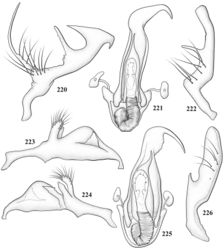Pilophoropsidea cuneata
| Notice: | This page is derived from the original publication listed below, whose author(s) should always be credited. Further contributors may edit and improve the content of this page and, consequently, need to be credited as well (see page history). Any assessment of factual correctness requires a careful review of the original article as well as of subsequent contributions.
If you are uncertain whether your planned contribution is correct or not, we suggest that you use the associated discussion page instead of editing the page directly. This page should be cited as follows (rationale):
Citation formats to copy and paste
BibTeX: @article{Henry2015ZooKeys, RIS/ Endnote: TY - JOUR Wikipedia/ Citizendium: <ref name="Henry2015ZooKeys">{{Citation See also the citation download page at the journal. |
Ordo: Hemiptera
Familia: Miridae
Genus: Pilophoropsidea
Name
Pilophoropsidea cuneata Henry sp. n. – Wikispecies link – ZooBank link – Pensoft Profile
Diagnosis
This species (Fig. 55) is recognized by the overall very dark brown head and hemelytra, contrasting with the dull or, at most, satiny, black pronotum; the field of silvery, scale-like setae across the basal half of the cuneus, and the male genitalia, particularly the left paramere (Fig. 220) with a long basal process.
Description
Male (n = 2; holotype measurements in parentheses): Length 4.03 mm (4.10 mm), width 1.10 mm (1.04 mm). Head: Width 0.76 mm (0.74 mm), interocular width 0.36 mm (0.32 mm). Labium: Length 1.30 mm (1.28 mm). Antenna: Segment I, length 0.30 mm (0.27 mm); II, 0.84 mm (0.80 mm); III, 0.54 mm (0.50 mm); IV, 0.52 mm (0.46 mm). Pronotum: Length 0.78 mm (0.74 mm), basal width 1.06 mm (1.04 mm).
Coloration: Head: Dark reddish brown. Antenna: Segment I pale brown, basal half with an elongate red mark on inner side; segment II fuscous to black; segment III and IV black. Pronotum: Fuscous to black. Scutellum: Dark brown to fuscous, apex pale brown. Hemelytron: Uniformly dark brown to fuscous; membrane uniformly smoky black. Ventral surface: Shiny reddish brown to fuscous. Ostiolar evaporative area: White, with knob at end of scent channel dull red. Legs: Fore coxa dark brown, middle and hind coxae white, narrowly fuscous at bases; femora uniformly dark reddish brown; tibiae dark reddish brown, hind tibiae noticeably flattened; tarsi and claws brown.
Structure, texture, and vestiture: Head: Granulate, frons with weak transverse striations. Labium: Extending just beyond bases of middle coxae. Pronotum: Evenly granulate, dull to weakly shiny, collar paler brown and transversely rugose. Scutellum: Finely granulate, smooth, with silvery scale-like setae across apical half except apex, intermixed with long, erect, simple setae. Hemelytron: Smooth, polished, with three bands or patches of silvery scale-like setae, one across base of clavus (and through scutellum), a broader one through middle of corium and apical third of clavus, and one across basal half of cuneus, intermixed with sparse, recumbent simple setae and a row of long, erect setae through middle of clavus and a few along inner corial margin at base of membrane. Ventral surface: Abdomen with numerous long, erect setae, especially on genital capsule.
Male genitalia: Aperture with a large tubercle along dorsal edge just left of center (approx. at 11 o’clock position) that is thickened on basal half, then abruptly slender apically. Left paramere (Fig. 220): Apex subtriangular or beak-like, middle with a relatively stout, erect process, and base with a very long, forward-curving, slender process. Right paramere (Fig. 222) elongate, with a short, slender process at middle. Phallotheca (Fig. 221) slender, apex with a stout, recurved hook.
Female: Unknown.
Etymology
The specific epithet cuneata is used to denote the silvery, scale-like patch of setae present across the basal half of the cuneus.
Distribution
Chiapas, Mexico.
Host
Unknown.
Type material
Holotype: ♂: MEXICO: Chiapas, 27 km SW Teopisca, 18 Sept. 1981, Clark and Coe (TAMU). Paratype: Same data as for holotype, 1♂ (USNM). [00162215].
Original Description
- Henry, T; 2015: Revision of the Ceratocapsine Renodaeus group: Marinonicoris, Pilophoropsis, Renodaeus, and Zanchisme, with descriptions of four new genera (Heteroptera, Miridae, Orthotylinae) ZooKeys, (490): 1-156. doi
Images
|

